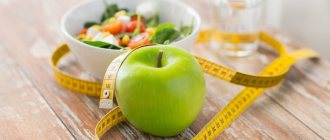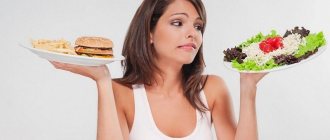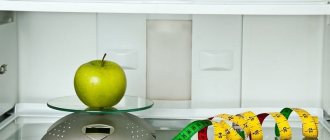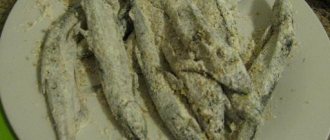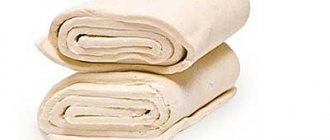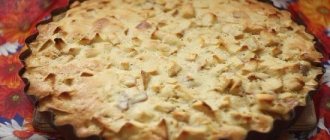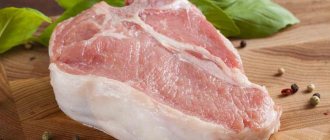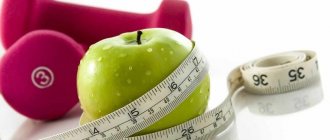Delicious dishes that can be prepared for future use.
Cold oatmeal, cutlets, meatballs, lasagna or stuffed peppers can be prepared for future use. The side dish “lives” in the refrigerator for a day, the sauce lasts for two days, eat the salad fresh, but you must cover it with a lid and under no circumstances leave a spoon inside.
It is better to buy bananas on the weekend and slightly unripe, so that they can be preserved until Friday and always be at hand. Don't be afraid of butter and full-fat milk, you're not a dry bikini, after all.
Cold oatmeal with fruits, berries and seeds
Yes, there is an error in the recipe: pumpkin seeds are called cardamom. Sorry.
Ingredients for four servings:
- 360 g oat flakes
- juice from 4 oranges
- 160 ml water
- 20 g pumpkin seeds
- 10 g sunflower seeds
- 20 g raisins
- 2 apricots
- 40 g blueberries
- 4 strawberries
- 4 spoons of natural yogurt
Take the largest oatmeal flakes, the least processed ones, that is, those that require cooking - they have more fiber and vitamins.
In the evening, put the flakes in a blender and squeeze the oranges into them (if the pulp gets in, it's okay - it tastes better), and then blend for 30-50 seconds. In a separate bowl, mix pumpkin seeds, sunflower seeds and raisins, cover them with water. Close the container with ground oatmeal tightly with a lid, and it would be better to cover the seeds and raisins with something. Place both bowls in the refrigerator and forget about them until the morning.
In the morning, place the oatmeal mixture on plates, add seeds and raisins to it, and then decorate the dish with your favorite fruits, berries, nuts, honey or natural yogurt. If you still have oatmeal left after breakfast, you can safely store it in the refrigerator for 2-3 days - nothing will happen to it.
We have calculated the calories for the ingredients listed above, so if you add anything else, the numbers will of course be different.
One 220g serving contains: 450 calories | 14 g protein | 9.7 g fat | 74 g carbohydrates
Important points for a calorie diet
Since the calculations are quite complex, it is recommended to prepare a menu for the week in advance. One of the most important points is five meals a day with calories calculated in the following ratio: breakfast - twenty-five percent, second breakfast - ten percent, lunch - within thirty percent, afternoon snack - up to twenty-five percent, dinner - ten percent.
To ensure that the body does not suffer from the lack of vital substances, it is necessary to include five food groups in the diet:
- polyunsaturated fats;
- fruits;
- cereals;
- proteins;
- vegetables.
Sandwich with ham, tomato and cheese

Ingredients for two servings:
- 2 slices of rye bread
- 1/4 medium tomato
- 2 slices of ham (50 g)
- 2 slices hard cheese (50 g)
Cut, fold, eat.
One serving contains: 382 kcal | 24 g protein | 19 g fat | 26 g carbohydrates
Note for "skinny" guys
If you are underweight, you should increase your daily diet until you reach normal height and weight levels. For skinny guys, you can set the goal of gaining 1.5 to 3 kg every month until the weight reaches the lower limit of normal. The table will help you determine normal weight based on your body type.
| Height | Ectomorph | Mesomorph | Endomorph |
| 158 | 51,1 — 54,7 | 53,8 — 58,9 | 57,4 — 64,2 |
| 159 | 51,6 — 55,2 | 54,3 — 59,6 | 58,0 — 64,8 |
| 160 | 52,2 — 55,8 | 54,9 — 60,3 | 58,5 — 65,3 |
| 161 | 52,7 — 56,3 | 55,4 — 60,9 | 59,0 — 66,0 |
| 162 | 53,2 — 56,9 | 55,9 — 61,4 | 59,6 — 66,7 |
| 163 | 53,8 — 57,4 | 56,5 — 61,9 | 60,1 — 67,5 |
| 164 | 54,3 — 57,9 | 57,0 — 62,5 | 60,7 — 68,2 |
| 165 | 54,9 — 58,5 | 57,6 — 63,0 | 61,2 — 68,9 |
| 166 | 55,4 — 59,2 | 58,1 — 63,7 | 61,7 — 69,6 |
| 167 | 55,9 — 59,9 | 58,6 — 64,4 | 62,3 — 70,3 |
| 168 | 56,5 — 60,6 | 59,2 — 65,1 | 62,9 — 71,1 |
| 169 | 57,2 — 61,3 | 59,9 — 65,8 | 63,6 — 72,0 |
| 170 | 57,9 — 62,0 | 60,7 — 66,6 | 64,3 — 72,9 |
| 171 | 58,6 — 62,7 | 61,4 — 67,4 | 65,1 — 73,8 |
| 172 | 59,4 — 63,4 | 62,1 — 68,3 | 66,0 — 74,7 |
| 173 | 60,1 — 64,2 | 62,8 — 69,1 | 66,9 — 75,5 |
| 174 | 60,8 — 64,9 | 63,5 — 69,9 | 67,6 — 76,2 |
| 175 | 61,5 — 65,6 | 64,2 — 70,6 | 68,3 — 76,9 |
| 176 | 62,2 — 66,4 | 64,9 — 71,3 | 69,0 — 77,6 |
| 177 | 62,9 — 67,3 | 65,7 — 72,0 | 69,7 — 78,4 |
| 178 | 63,6 — 68,2 | 66,4 — 72,8 | 70,4 — 79,1 |
| 179 | 64,4 — 68,9 | 67,1 — 73,6 | 71,2 — 80,0 |
| 180 | 65,1 — 69,6 | 67,8 — 74,5 | 71,9 — 80,9 |
| 181 | 65,8 — 70,3 | 68,5 — 75,4 | 72,7 — 81,8 |
| 182 | 66,5 — 71,0 | 69,2 — 76,3 | 73,6 — 82,7 |
| 183 | 67,2 — 71,8 | 69,9 — 77,2 | 74,5 — 83,6 |
| 184 | 67,9 — 72,5 | 70,7 — 78,1 | 75,2 — 84,5 |
| 185 | 68,6 — 73,2 | 71,4 — 79,0 | 75,9 — 85,4 |
| 186 | 69,4 — 74,0 | 72,1 — 79,9 | 76,7 — 86,2 |
| 187 | 70,1 — 74,9 | 72,8 — 80,8 | 77,6 — 87,1 |
| 188 | 70,8 — 75,8 | 73,5 — 81,7 | 78,5 — 88,0 |
Dinner
Meatballs with cheese

Ingredients for two servings:
- 250 g minced pork and beef
- 1 medium onion
- 40 g large oat flakes
- 50 g of any hard cheese
- salt, pepper, spices to taste
- sunflower oil
Turn the oven on to 200 degrees and let it heat up. Wash, peel and chop the onion as finely as you can. Pour boiling water over the oatmeal so that it covers 1 cm. Cut the cheese into cubes about 1x2 cm. Place the minced meat in a deep bowl, add salt, pepper and, if you want, add spices (basil, oregano, dill, cumin, etc.), onion and squeezed water flakes. Mix the minced meat thoroughly with your hands.
Place the frying pan over high heat and grease it with oil. When the oil is hot, wet your hands with cold water and roll the minced meat into a ball. Flatten it slightly and place a block of cheese in the center, then remember your golden childhood and roll it into a neat sphere, which you then need to put on a hot, oiled frying pan and fry until golden brown on all sides. Process all the minced meat in this way, and then put the fried meatballs in a heat-resistant form, cover with foil or a lid and place in the oven for 10-12 minutes.
One serving (200 g) contains: 593.4 kcal | 40 g protein | 40 g fat | 14 g carbohydrates
Rice with vegetables
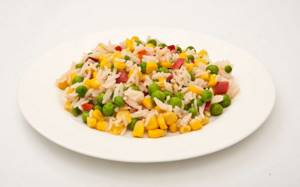
Ingredients for two servings:
- 1 cup (200g) rice
- 1 medium carrot
- 1 medium onion
- 1 red bell pepper
- 1 clove of garlic
- 80 g frozen green peas
- 80 g canned corn
- 20 g olive oil
- 400 ml boiling water
- salt, pepper, spices to taste
All vegetables need to be washed, carrots, onions and garlic need to be peeled, seeds and membranes removed from the peppers, nothing needs to be done with the peas - let them rest in the freezer for now. Rinse the rice, and if it is in a bag, boil it as directed on the package.
Grate the carrots on a coarse grater, chop the onion and pepper into pieces of a size you like, and crush the garlic with the flat side of a knife and chop it up a little. The crushed garlic should be placed in a preheated and oiled deep frying pan or pan (it is better to have a non-stick bottom). Fry the garlic for 10-15 seconds, and add onions, carrots and bell peppers. Stirring occasionally, fry this whole bunch for 7-9 minutes, then add ice peas to them and, periodically repeating rotational movements with a spoon inside your frying pan, keep the vegetables over medium heat and covered for another 5 minutes.
If you've used bagged rice, you're at the finish line. You need to combine the finished rice with vegetables and simmer over medium heat for 3-5 minutes. And if you are not looking for easy ways, then put the water to boil, and while it is heating up, add dry rice to the vegetables. When the water boils, reduce the heat under the pan to low and pour in enough liquid to cover the rice and vegetables by two fingers. Close the lid and simmer for 15-20 minutes. You need to stir the whole thing and build a “slide” every five minutes, collecting rice from the edges and lifting it from the bottom. Once all the water has been absorbed, turn off the burner, close the lid and let stand for another 5-10 minutes without heating.
One serving (250 g) contains: 478.4 kcal | 10 g protein | 10 g fat | 84 g carbohydrates
Cabbage and cucumber salad

Ingredients for two servings:
- 200 g Chinese cabbage
- 2 medium cucumbers
- 1/2 green apple
- 1 tablespoon olive oil
- salt, pepper, herbs to taste
Wash everything, peel the cucumbers and apple. Roughly chop cucumbers, cabbage and apples, season with oil, salt and pepper. All.
One serving contains: 74.3 kcal | 1.4 g protein | 5.3 g fat | 4.7 g carbohydrates
At what rate should I gain weight?
An aspiring natural bodybuilder who trains hard and eats right should gain between 10 and 10 pounds of muscle mass in the first year of hardcore training. Athletes with an average level of training and experienced bodybuilders will not gain weight as quickly. According to Casey Butt, a natural bodybuilder can expect the following rates of muscle gain:
- 1 year
– 7-8 kg of muscle mass - 2 year
– 4 kg muscle mass - 3 year
– 2 kg muscle mass - 4 year
– 1 kg of muscle mass - 5 year
– 0.5 kg of muscle mass
As you increase muscle mass, you will inevitably accumulate some fat. A little. Remember, your muscle gain strategy doesn't have to turn you into a sumo wrestler, but you are allowed to gain between 2.5 and 5 kg of body fat per year. Some will gain more fat, some will gain less. If you fear fat and undereat, you will severely limit your potential for gaining muscle mass. Bodybuilding requires creation, and for this you have to eat more. You won't make the most progress if you cut back on your diet. It will be a long time before you see those six-pack abs again, but by then you will have become a real muscle monster!
Below is an approximate plan for gaining muscle mass based on your level of physical fitness and existing experience with muscle growth:
- Beginners.
Beginning bodybuilders who have not previously worked on gaining muscle mass should set the bar at gaining 1 kg of total mass per month for the first year. Ideally, this will allow you to gain 8 kg of muscle and 4 kg of fat mass. - Repeaters.
Repeaters (or those who have already gained about 8 kg of muscle mass) should move the bar by 0.5 kg per month, and so on over the next year. Ideally, this would correspond to 4 kg of muscle and 2 kg of fat tissue. - Middle peasants.
In the third year, weightlifters (as well as those who have already gained 12 kg of muscle mass) should set a goal of gaining 1 kg every 3 months. Ideally, this schedule will help you gain 2 kg of muscle and 2 kg of fat mass. - Experienced.
Weightlifters who have passed the 3-year mark (as well as those who have gained about 14 kg of muscle mass) should set themselves the goal of gaining 0.5 kg per two months during the fourth year of training. Under ideal circumstances, this will lead to a gain of 1 kg of muscle and 2 kg of fat. - Advanced.
If you are in your fifth year of training (or longer) or have already gained about 15 kg of muscle mass, you should set a goal of gaining 0.5 kg of total mass every 2 months, and so on for a year. At best, this will allow you to gain 0.5-1 kg of muscle and 2 kg of fat mass.
Example of a nutrient intake program
The following nutrient program is provided as a sample and is intended to be used with the muscle building diet suggested above. Modify it to suit your individual needs.
- 6:00 – Get up!
– 5 grams of glutamine and 5 grams of BCAA. - 6:30
– 1 gram of fish oil, multivitamin preparation. - Noon
– 1 gram of fish oil. - 14:30
– 40 grams of waxy maize (with casein protein shake). - 15:00 – 30 minutes before training
– 5 grams of BCAA, 5 grams of creatine, nitric oxide donor. - 15:30 – Training!
- 16:30 – Post-workout complex:
5 grams of BCAA, 5 grams of glutamine, 5 grams of creatine, 40 g of waxy maize. - 17:30
– 1 gram of fish oil. - 20:30 — To the side!
5 grams glutamine, ZMA.
Your choice of beta-alanine.
Promising research has found a synergistic interaction between creatine and beta-alanine. Beta-alanine should be taken every 4 hours at a dosage of 750-800 mg. While taking beta-alanine, it is advisable to take additional taurine. To learn more about the interaction between beta-alanine and creatine, check out Creatine and Beta-Alanine Tandem: The Secret Weapon for Maximum Results.
